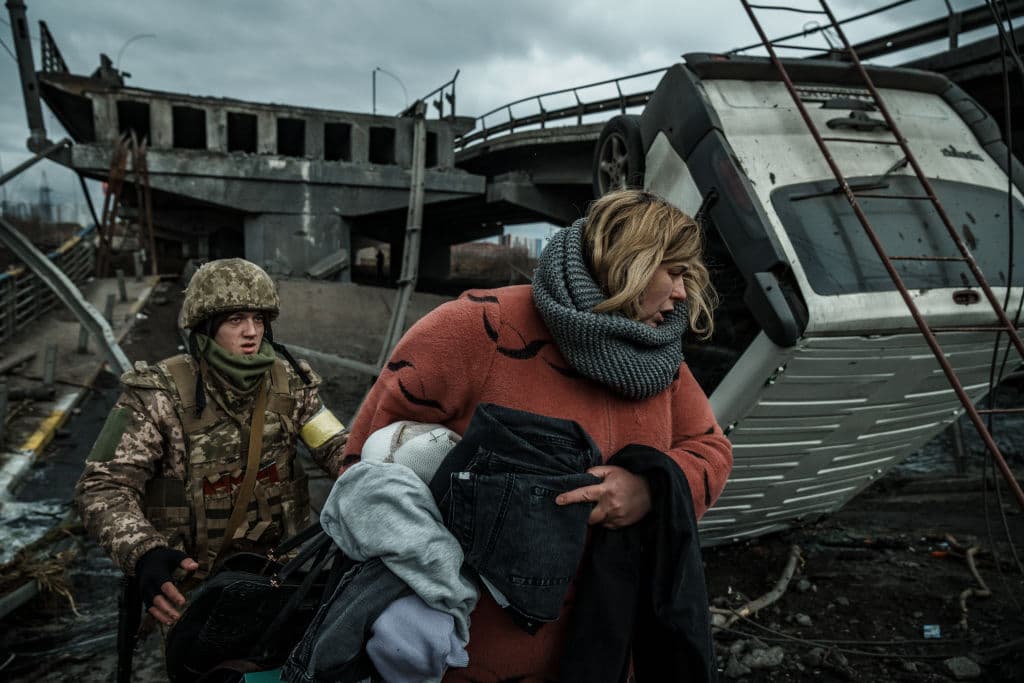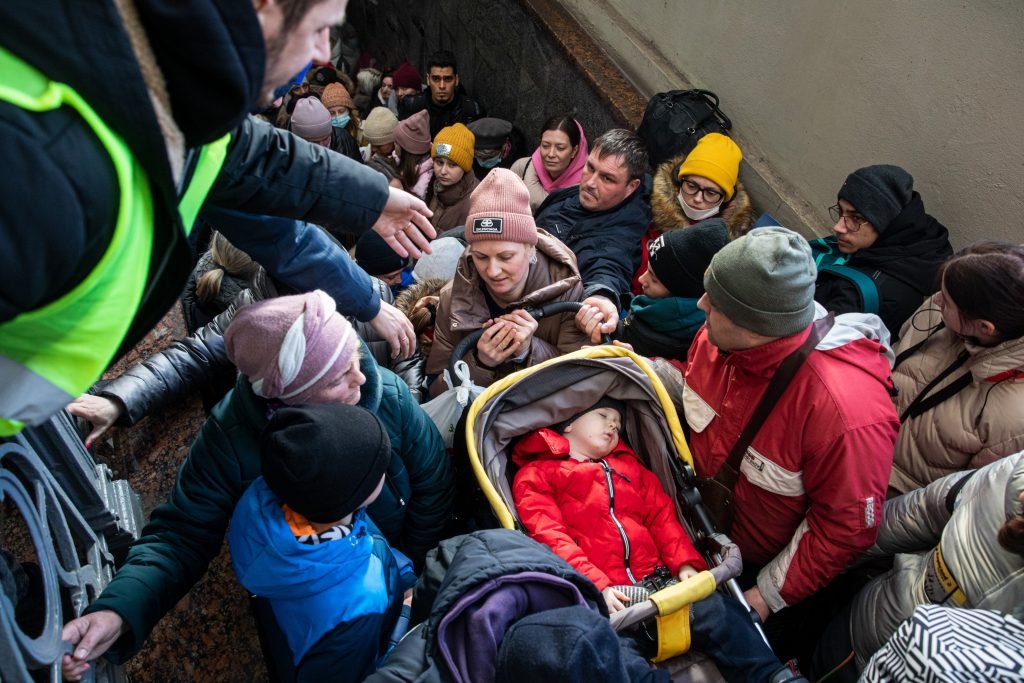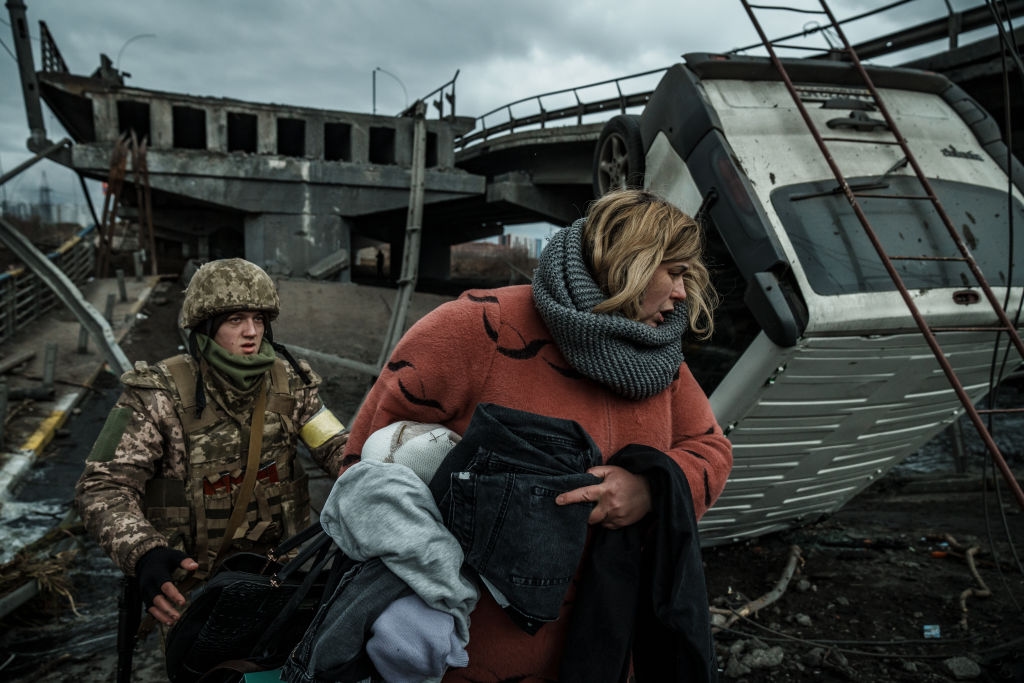Ukraine's year at war: 2022 in 22 photos

For Ukraine, the story of 2022 is the story of war.
Russia's war against Ukraine started in 2014 in Crimea and Donbas, but it turned into a full-scale invasion in 2022.
This year, the war has killed tens of thousands and forced millions to flee their homes. Russia has bombed civilian infrastructure in Ukraine, sometimes razing cities to the ground. International reports have confirmed that Russian soldiers have committed numerous war crimes in the occupied territories of Ukraine.
From the outset, Russia attempted to sack Ukraine's major cities, including Kyiv, the country's capital. Russia failed to achieve its goals and eventually lost its gains in the north, as well as in the south in Kherson. Suffering major defeats on the battlefield, Russia has increased its missile attacks against Ukraine's civilian energy infrastructure, causing power outages all across the country. As the year is ending, Russian troops continue to try to advance in the east.
Russia's full-scale invasion was the definitive event for the world in 2022, with consequences being felt across various fields, including energy and food security. President Volodymyr Zelensky was named the person of the year by a number of publications. Meanwhile, the International Criminal Court has launched an investigation into Russia's alleged war crimes in Ukraine.
The Kyiv Independent picked 22 photos representing Ukraine's hardest, darkest, and most important year.
February
Russia's plans to launch a full-scale invasion of Ukraine were discussed months before the invasion actually happened.
Despite Ukrainian officials publicly rebuffing warnings from the U.S. that Russia was preparing to conduct an all-out assault on Ukraine, the country geared up for war.
In early 2022, Ukraine launched the Territorial Defense Force to prepare civilian volunteers to defend their cities and regions in case of a Russian assault. The initiative proved to be extremely effective, with Territorial Defense Force units successfully defending Kyiv and Kharkiv after Russia moved in.
On Feb. 24, Russian troops descended upon the country from five directions, igniting the deadliest war in Europe since World War II.
Over seven million people have been forced to flee Ukraine, while tens of thousands of civilians have been murdered and injured by the invading Russian troops.

Civilians, members of the 130th Territorial Defense Unit, take part in drills in Kyiv on Feb. 12, 2022. (Kostyantyn Chernichkin)

Residents of Kyiv flee as Russians strike the capital of Ukraine on Feb. 24, de facto proclaiming war. (Getty Images)

Helena, a 53-year-old teacher, stands outside a hospital after the Russian bombing of the eastern Ukraine town of Chuhuiv on Feb. 24, 2022, as Russians invaded Ukraine. (Aris Messinis / AFP/Getty Images)

Ukrainians fleeing the war to Poland cram the Lviv train station on Feb. 28, 2022. (Kostyantyn Chernichkin)
March
In March, Russia was actively advancing in Ukraine's northern Kyiv, Chernihiv, and Sumy oblasts, southern Kherson, Mykolaiv, and Zaporizhzhia oblasts, as well as eastern Kharkiv, Luhansk, and Donetsk oblasts.
Russia occupied Kherson in early March while continuing to try to take other major cities – Kyiv, Kharkiv, Mykolaiv, and Mariupol.
The southeastern port city of Mariupol, home to 450,000 people before the full-scale war, would become the site of one of the war's deadliest battles. Russia bombarded the city for months, killing tens of thousands of civilians and turning the once prosperous city into a landscape of rubble.

A female resident escorted by a Ukrainian soldier crosses a makeshift walkway over a destroyed bridge during the evacuation from Irpin, near Kyiv, on March 5, 2022. (Photo by Serhii Mykhalchuk/Global Images Ukraine via Getty Images)

A father puts his hand on a train that departs with his daughter from the Odesa train station on March 7, 2022. (Getty Images)

Ukrainian emergency workers carry an injured pregnant woman after Russian troops shelled a maternity hospital in Mariupol, Donetsk Oblast, on March 9, 2022. The woman and her unborn baby died following the attack. (Evgeniy Maloletka)
April
If early March was the time of rapid Russian advances, late March was the time of swift Russian retreat.
Failing to sack Kyiv, Russian troops began to withdraw from the city's suburbs and surrender large territories in Kyiv, Chernihiv, and Sumy oblasts.
After the Russians left Kyiv Oblast in early April, the world learned of the massive scale of war crimes committed by the invading army.
The Bucha Massacre was the epitome of Russia's criminal activity. In Bucha, a town near Kyiv, at least 458 civilians were murdered. Many of them suffered torture. Soon, stories of rape, torture, and murder began appearing in every place where Russian troops had been stationed. In total, over 1,300 civilians were murdered in Kyiv Oblast.
One of the deadliest attacks of the war took place on April 8, when Russians hit the Kramatorsk train station, packed with civilians trying to evacuate from the war-torn region. Fifty-seven civilians were killed and 109 injured.

This aerial picture shows burned Russian armored vehicles on the outskirts of Kyiv, on April 1, 2022. (Ronaldo Schemidt/AFP/Getty Images)

President Volodymyr Zelensky (C) speaks to the media in the town of Bucha, northwest of the Ukrainian capital Kyiv, on April 4, 2022. In Bucha, bodies were found lying in the street after the Russian army was forced out of the town. (Photo by RONALDO SCHEMIDT/AFP via Getty Images)
May
Despite facing defeat in Ukraine's north, Russia continued to advance in the south.
By May, Russian troops surrounded and destroyed Mariupol, with Ukraine's last stand being the Azovstal steel mill defended by several thousands of Ukrainian soldiers, police officers, and border guards. The Azov Battalion was among the key Ukrainian units defending the plant.
On May 16, Ukrainian defenders were ordered to surrender. Russian troops have been occupying the city ever since.
Commanders of the Azovstal defense, including Denys Prokopenko, the head of the Azov regiment at the then-besieged Azovstal steel plant, his deputy Svyatoslav Palamar, and marine commander Serhiy Volynsky, were among the 215 people released from Russian captivity in a massive prisoner exchange on Sept. 21.

A Ukrainian serviceman stands under a beam of light in the basement of the Azovstal steel factory in besieged Mariupol amid Russia's assault on the city. The image was released on May 10, 2022, by its author Dmytro Kozatskyi, a soldier of the Azov Battalion, who is now in captivity. (Dmytro Kozatskyi)
June
Russia continued to barrage Ukraine with artillery fire, advancing in the country's east.
After a drawn-out battle between Ukrainian and Russian forces, Russia managed to take the city of Sievierodonetsk in Luhansk Oblast and, with it, the entire oblast while continuing to advance and effectively destroy neighboring Donetsk Oblast.
Severely outgunned, Ukraine's leadership had called on the West to provide additional artillery. In the summer months, Russians was firing up to 60,000 artillery shells daily. According to Zelensky, Ukraine was losing between 100 and 200 soldiers every day in May and June. That number went down to 30 per day by the end of July, he said.
At the end of June, the first HIMARS systems provided by the U.S. arrived in Ukraine. They would make a change on the battlefield, allowing Ukraine to carry out precise hits of Russian logistical targets.
At the end of June, the city of Sievierodonetsk fell to Russian troops. It became the last major Russian battlefield achievement in the 2022 campaign.

Residents look for belongings in the rubble of their home after a strike destroyed three houses in the city of Sloviansk on June 1, 2022. (Aris Messinis/AFP/Getty Images)

The funeral ceremony for 27 Ukrainian servicemen who died fighting with the Russians on the eastern front line, in the military part of Krasnopilske cemetery in Dnipro, Ukraine, on June 3, 2022. 12 of the Ukrainian soldiers were buried unidentified. (Photo by Wojciech Grzedzinski/ for The Washington Post via Getty Images)
July
Russians actively bombarded Ukraine, killing military personnel and civilians alike.
Kharkiv, Ukraine's second-largest city home to over 1.4 million people, was bombarded daily. The city's Saltivka neighborhood became one of the deadliest places in the country.
West of Kyiv, a devastating Russian missile strike on a shopping mall and concert hall in downtown Vinnytsia on July 14 killed 23 people and injured at least 117.

A father kneels by the body of a teenager who died in a Russian missile strike at a bus stop in Saltivka, a northern district of Kharkiv, on July 20, 2022. (Sergey Bobok/AFP/Getty Images)
August
Ukraine was able to withstand the Russian offensive during the summer and successfully accumulated enough firepower to prepare a counteroffensive.
On Aug. 24, Ukraine celebrated its Independence Day. Destroyed Russian military equipment was on display on Kyiv's central Khreshchatyk Street.
"This is proof that enemy equipment can appear in the center of Kyiv only in such form – burnt, wrecked, and destroyed," said Zelensky. "Having gone through so much, we have no right not to give up. What is the end of the war for us? We used to say – peace. Now we say – victory," he added.

Children hold a Ukrainian flag as they pose for a photo in front of a damaged Russian military vehicle displayed in central Kyiv on Aug. 24, 2022. (Kostyantyn Chernichkin)
September
In September, Ukraine launched its surprise counteroffensive in the northeastern Kharkiv Oblast, pushing Russians out of the cities of Izuim, Balaklia, and Kupiansk. Over 150,000 people were liberated as a result of Ukraine's successful push.
After Ukraine liberated nearly all of Kharkiv Oblast, more Russian atrocities were uncovered, with torture chambers and mass burial sites with hundreds of civilian bodies uncovered by Ukrainian law enforcement.
In response to this humiliating military defeat, Russian President Vladimir Putin announced his country was annexing four Ukrainian oblasts – Kherson, Zaporizhzhia, Donetsk, and Luhansk. Russia didn't control any of the four regions in full, having failed to take the regional capital Zaporizhzhia.
Ukraine's continued advances thwarted Russia's attempts to legalize the occupation of Ukrainian territory it had claimed to annex.

Ukrainian authorities exhume bodies of people killed by Russia in Izium, Kharkiv Oblast, Ukraine, on Sept. 16, 2022. (Kostyantyn Chernichkin)

A man walks between apartment buildings severely damaged by Russian shelling during the battle of Izium on Sept. 14, 2022. (Kostyantyn Chernichkin)
October
After liberating Ukraine's northeastern Kharkiv Oblast, Ukraine geared up to retake Kherson. Explosions on military sites deep in Russian-occupied territories began to be regular occurrences, while Russia, facing defeat on the battlefield, shifted its attention to Ukraine's civilian infrastructure.
On Oct. 8, explosions occurred on the Crimean Bridge, the strategic bridge that connects Russia with the occupied Crimea peninsula over the Kerch Strait, built after Russia annexed Crimea in 2014. Ukraine never claimed responsibility for the attack.
Two days later on Oct. 10, Russia launched its first of a series of mass missile strikes on civilian sites across the country, including critical energy infrastructure, killing and injuring dozens.
Since then, Russia has launched seven mass missile strikes on Ukraine, killing dozens of civilians and forcing emergency blackouts across the country, along with other, smaller attacks.

Black smoke billows from a fire on the Crimean Bridge that links occupied Crimea to Russia, on Oct. 8, 2022. A truck has exploded on the Russian-controlled bridge used to ship military to Ukraine's occupied peninsula. Russia blamed the attack on Ukraine. (AFP/Getty Images)

A Ukrainian soldier rests on the sidewalk after the Russian attacks on Kyiv, Ukraine, on Oct. 17, 2022. Russia began launching missiles and loitering munition on civilian infrastructure across Ukraine on Oct. 10. (Metin Aktas/Anadolu Agency/Getty Images)
November
The high point of November was the liberation of Kherson — the only regional capital Russia managed to capture — on Nov. 11, forcing Russian troops to the east bank of the Dnieper River. That week, Ukraine liberated over a hundred settlements in Kherson Oblast.
As with other territories freed from Russian occupation, liberation came with the discovery of Russian war crimes. Despite being cleared of Russian troops, Kherson is still under near-daily shelling from Russian troops stationed across the river.
Russia continued to launch more waves of massive missile attacks all over Ukraine, killing civilians and damaging energy infrastructure. Millions in Ukraine were subject to frequent power, heat, and water outages.

A Ukrainian soldier of an artillery unit fires towards Russian positions outside Bakhmut on November 8, 2022, amid the Russian invasion of Ukraine. (Bulent Kilic/AFP/Getty Images)

Ukrainian lawmaker turned soldier, Roman Lozynskyi, signs Ukrainian flags of Kherson residents on Nov. 12, in Kherson, Ukraine. (Yevhenii Zavhorodnii)

Doctors operate using flashlights after Russian attacks caused power outages in Kyiv, Ukraine, on Nov. 30, 2022. (Getty Images)
December
Contrary to many predictions, Ukraine managed to withstand Russia's all-out assault for nine months.
The winter continues to be difficult as Russian missile attacks on Ukraine's energy infrastructure become a regular occurrence, and people are left without power, heat, and water, sometimes for hours or days on end. Russia launched its 7th mass missile attack on Dec. 16, firing a total of 76 cruise missiles at targets across Ukraine.
The fiercest battle along the more than 1,300-kilometer front line is now in Bakhmut, Donetsk Oblast, as Russian troops relentlessly try to capture the city in an effort to occupy the entire oblast. President Zelensky visited troops on the front line near Bakhmut on Dec. 20.
As Ukraine receives more advanced military support from the West, the country looks poised to have the upper hand against Russia in the battles to come. Reports of a fourth Ukrainian counteroffensive in Zaporizhzhia Oblast have begun to emerge.
Ukrainian officials have also predicted that Russia is planning to launch a new major offensive at the start of 2023.

A Ukrainian soldier, heavily wounded in battle within the Russian-Ukrainian war, waits to receive medical treatment at Bakhmut Hospital in Bakhmut, Donetsk Oblast, Ukraine on December 5, 2022. (Metin Aktas/Anadolu Agency/Getty Images)












